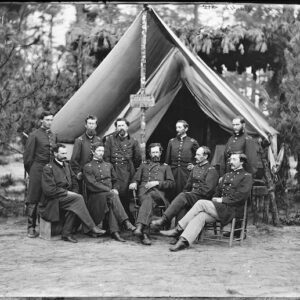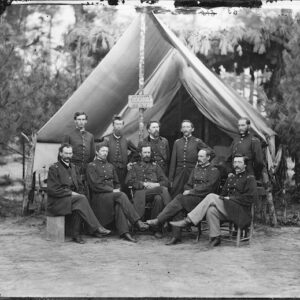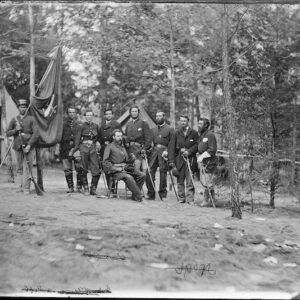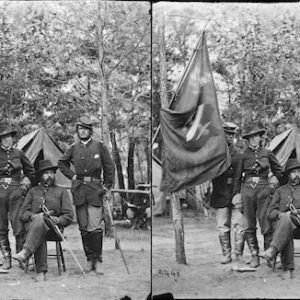Tag: 9th Corps (3rd Division)
Wikipedia says: IX Corps (Ninth Army Corps) was a corps of the Union Army during the American Civil War that distinguished itself in combat in multiple theaters: the Carolinas, Virginia, Kentucky, Tennessee, and Mississippi.
Formation, Second Bull Run, and Antietam
Although the official order designating its number was not issued until July 22, 1862, the IX Corps organization dates from the expedition to North Carolina in February, 1862, under Ambrose E. Burnside and to the operations about Hilton Head, South Carolina, because the troops engaged in these movements were the only ones used in the formation of the corps. The corps was assembled by Burnside at Newport News, Virginia, from his two brigades from North Carolina and Isaac Stevens’s division from Hilton Head. The corps consisted of three divisions, under Generals Stevens, Jesse L. Reno, and John G. Parke.
After a short stay at Newport News the corps was ordered to reinforce Maj. Gen. John Pope’s Army of Virginia, and at Second Bull Run it fought its first battle as the IX Corps. Only the two divisions of Stevens and Reno were engaged in this action; they numbered 12 regiments and 2 batteries, fewer than 5,000 men. General Reno was in command of both divisions in Burnside’s absence. The losses in this small engagement amounted to 204 killed, 1,000 wounded, and 319 missing; total, 1,523. Some of the regiments encountered a severe fire, the 28th Massachusetts losing 234 men. General Stevens was killed at Chantilly.
General Reno retained command of the corps on the Maryland Campaign, General Burnside having charge of the right wing of the Army of the Potomac, which was composed of the I and IX Corps. Brig. Gen. Orlando B. Willcox was appointed to the command of Stevens’s (1st) Division, while the 2nd and 3rd Divisions were commanded, respectively, by Generals Samuel D. Sturgis and Isaac P. Rodman. During this campaign Jacob D. Cox’s Kanawha Division from western Virginia was temporarily attached to the corps. The command had also been greatly strengthened by the accession of several new regiments, just organized under the recent call for troops, and its four divisions now numbered 29 regiments and 5 batteries, with 13,819 present for duty, including non-combatants.
The Battle of South Mountain was fought wholly by Burnside’s two corps, the IX Corps losing 157 killed, 691 wounded, and 41 missing; total, 889. The loss in the I Corps was about the same. General Reno was killed in this action, upon which General Cox succeeded to his command. At Antietam the corps lost 438 killed, 1,796 wounded, and 115 missing; total, 2,349, out of about 8,500 in action. General Rodman was among the mortally wounded. In October, Cox’s Division returned to western Virginia and its brief connection with the corps terminated. This division had made a brilliant record by its gallant services at South Mountain and Antietam.
Upon the departure of General Cox the command of the corps fell to General Willcox. General William W. Burns was appointed to fill the vacancy thus caused in the 1st Division, and Brig. Gen. George W. Getty was placed in command of the 3rd Division, formerly Rodman’s. On November 5, 1862, General Burnside was made commander-in-chief of the Army of the Potomac.
At Fredericksburg, the casualty lists indicate that the corps took into action 31 regiments and 5 batteries, with a loss of 111 killed, 1,067 wounded, and 152 missing; total, 1,330. Not long after this battle Maj. Gen. John Sedgwick was assigned to the command of the corps, and General Willcox returned to the command of his division, relieving General Burns.
Western Theater
On February 5, 1863, Sedgwick was assigned command of VI Corps, and was succeeded by Maj. Gen. William F. “Baldy” Smith, and on February 12 the corps was ordered to Newport News, where it encamped for a month. General Smith’s stay with the corps was of short duration, for he was succeeded in the following month by Maj. Gen. John G. Parke. While at Newport News, Getty’s (3rd) Division was detached and ordered to Suffolk, Virginia, where it was subsequently incorporated into the VII Corps. It never rejoined its old command although, in 1864, one of its regiments, the 4th Rhode Island, was restored to the IX Corps.
In the meantime, General Burnside had been assigned to the command of the Department of Ohio, a district that included Kentucky and eastern Tennessee. He obtained permission for the transfer of his old corps to this field of operations, and on March 19, 1863, General Parke was ordered to proceed there with his two remaining divisions, Willcox’s and Sturgis’s. Just prior to the departure from Virginia, General Sturgis was relieved, and Brig. Gen. Robert B. Potter was assigned to the command of the 2nd Division. The IX Corps was stationed in Kentucky for two months, during which it served as an army of occupation. In June it was ordered to the support of Ulysses S. Grant, who was then besieging Vicksburg, and proceeding there promptly, it participated in the investment of the city, although not under fire. Upon the surrender of Vicksburg, Parke’s two divisions joined the main army in its movement on Jackson, Mississippi, and became engaged in the fighting there, with a loss of 34 killed, 229 wounded, and 28 missing; total, 291. The 1st Division was then under command of Brig. Gen. Thomas Welsh, General Willcox having been assigned to duty in Indiana. The Vicksburg Campaign had been a costly one for the Corps, not due to battle casualties, but to disease. Among those who succumbed to the deadly malaria of the Vicksburg camps was General Welsh, who, soon after, went home to die.
The corps left Mississippi in August, 1863, and returned to Kentucky, where, after a short rest, it joined in Burnside’s advance into East Tennessee, a movement that had already commenced. The two divisions were now reduced to about 6,000 men. General Parke having been made chief of staff of the Army of the Ohio, General Potter succeeded to the command of the corps, with Brig. Gen. Edward Ferrero and Col. John F. Hartranft in command of the two divisions.
Ferrero’s Division had a sharp little fight at Blue Springs, Tennessee, October 10, 1863, and the whole corps was engaged, November 16, at Campbell’s Station. This was followed by the occupation of Knoxville and the gallant defense against James Longstreet’s besieging forces, terminating December 4, in the defeat and withdrawal of the enemy.
Overland Campaign
General Willcox resumed command of the corps on January 17, 1864, relieving General Potter; on January 26, Parke relieved Willcox, who then took command of the 2nd Division.
General Burnside was again assigned to duty as commander of his old corps, which was ordered to Annapolis, Maryland, for reorganization. In April, the corps was composed of the four divisions of Thomas G. Stevenson, Potter, Willcox, and Ferrero, the latter division being composed wholly of African-American troops. The corps numbered 19,331 present for duty, with 42 pieces of field artillery; but this number was soon increased, the morning reports of May 10 showing a strength of 32,708. In addition to the four divisions, with their two batteries each, there was a brigade of reserve artillery of six batteries and a provisional brigade of heavy artillerymen and dismounted cavalry. In all, there were 42 regiments of infantry, and 14 batteries of light artillery. Ferrero’s Colored Division had never been under fire, while many of the white regiments in the corps were newly organized, or had served previously on garrison duty only. In the ranks of the old regiments were many recruits and conscripts.
In the Overland Campaign, Ulysses S. Grant launched a major offensive against Robert E. Lee starting in May, 1864. His command in Northern Virginia consisted of the Army of the Potomac, under Maj. Gen. George G. Meade, and the IX Corps operating separately, reporting directly to Grant. Burnside technically outranked Meade and objected to receiving commands from a junior officer. By the time of the Battle of North Anna, however, Grant acknowledged that this arrangement was ineffective and he convinced Burnside, along with General Parke, his chief-of-staff, to waive the question of their superiority of rank over Meade. On May 25, the IX Corps was assigned to the Army of the Potomac.
In the Battle of the Wilderness the corps lost 240 killed, 1,232 wounded, 168 missing; total, 1,640; and, at Spotsylvania, 486 killed, 2,119 wounded, 469 missing; total, 3,146; the heaviest loss at Spotsylvania Court House occurring in the action of May 12. The corps assaulted the right, eastern, flank of the “Mule Shoe” salient. General Stevenson was killed at Spotsylvania on May 10, and Maj. Gen. Thomas L. Crittenden, formerly commander of the XXI Corps, was assigned to the command of Stevenson’s (1st) Division.
Petersburg and the Crater
On June 9, at Cold Harbor, General Crittenden was relieved at his own request, and Brig. Gen. James H. Ledlie was placed in command of the 1st Division. In the first assault on Petersburg, June 17, the corps made a brilliant attack, Potter’s Division gaining possession of the works; unfortunately, the division was obliged to relinquish its foothold for want of proper support. The corps was engaged in a similar attempt on the following day, the losses in Potter’s and Willcox’s Divisions being unusually severe in proportion to the number engaged. Losses were 497 killed, 3,232 wounded, and 262 missing; total, 2,991. The dead included former Brig. Gen. James St. Clair Morton, chief engineer of the corps.
The enemy’s works proving too strong for assault, the army entrenched itself in preparation for the ten-month siege that followed. On June 19, Ferrero’s (4th) Division of black troops rejoined the corps, having been absent during the whole of the previous campaign, engaged on duty at the rear. Ferrero’s men were now placed in the trenches with the other three divisions. The part of the line occupied by the IX Corps was very near the enemy’s works, and an incessant firing was kept up during the siege, resulting in a daily loss of men, killed or wounded. While there was a comparative quiet in front of the other corps positions, the men of the IX Corps were subjected to the terrible strain of a constant watchfulness and deadly exposure. The enemy seemed to be excited to an undue activity by the presence of Ferrero’s Colored Division.
The IX Corps was prominently connected with the siege because of its role in the infamous Battle of the Crater, in which a lengthy mine shaft was dug from its line to under the Confederate works. This mine, which was excavated by the coal miners of 48th Pennsylvania, Potter’s Division, was successfully exploded with four tons of gunpowder, resulting in an enormous crater, but the assault that followed was a failure. Just before the assault, Grant and Meade directed Burnside to replace Ferrero’s black division with Ledlie’s white division, fearful of the political consequences of using black troops at the forefront of a major assault. But Ledlie’s troops were not trained for the assault and Ledlie himself remained in the rear area, inebriated. The assault was a fiasco, in which Union soldiers charged into the crater, becoming trapped there, easy targets for the Confederates along the crater’s rim. Ferrero’s black regiments went into action in the rear and fought well, but had no chance for success. The losses in the IX Corps at the crater were 473 killed, 1,646 wounded, 1,356 missing; total, 3,475. Immediately after this engagement, General Ledlie was relieved from command of the 1st Division, and Brig. Gen. Julius White, of the XXIII Corps, was assigned to Ledlie’s place.
On August 13, 1864, General Burnside was granted a leave of absence; he never rejoined the corps, but was succeeded by General Parke, who remained in command until the close of the war. At the battle of the Weldon Railroad, August 19–21, 1864, the three divisions of White, Potter, and Willcox were engaged with considerable loss, although the three combined numbered less than 6,000 muskets; casualties were 60 killed and 315 wounded. By this time the divisions had become so reduced in numbers that a reorganization of the corps became necessary, and so the regiments in White’s Division were transferred to the divisions of Potter and Willcox. Under this arrangement Willcox’s Division was numbered as the 1st; Potter’s, as the 2nd; Ferrero’s black troops were designated as the 3rd Division. But in December, Ferrero’s Division was permanently detached, and most of his regiments were transferred to the newly organized XXV Corps, which was composed entirely of black troops. General Ferrero himself was assigned to a provisional command at Bermuda Hundred.
1865
The vacancy caused by detaching Ferrero’s Division was filled by six new regiments of Pennsylvanians on one-year enlistments, organized into a division of two brigades, the command of which was given to General John F. Hartranft. This division rendered gallant service at Fort Stedman, and Hartranft added to his laurels by the ability displayed at that critical juncture.
The morning report for March 31, 1865, showed a corps strength of 18,153, “present for duty, equipped,” and 36 pieces of light artillery. With this force the IX Corps entered upon the final campaign, taking a prominent part in the storming of Petersburg, April 2, 1865, which resulted in the evacuation of Richmond and the downfall of the Confederacy. The corps was not only among the foremost in this brilliant assault,[peacock term] but its flags were the first to wave over the public buildings of Petersburg. This was the last battle in which the corps participated, and on July 27, 1865, the IX Corps was officially disbanded.
Command history
Ambrose E. Burnside, Army of the Potomac: July 22, 1862 – August 3, 1862
Ambrose E. Burnside, Department of Virginia: August 3, 1862 – September 3, 1862
Jesse L. Reno, Army of the Potomac: September 3, 1862 – September 14, 1862
Jacob D. Cox, Army of the Potomac: September 14, 1862 – October 8, 1862
Orlando B. Willcox, Army of the Potomac: October 8, 1862 – January 16, 1863
John Sedgwick, Army of the Potomac: January 16, 1863 – February 5, 1863
William F. Smith, Department of Virginia: February 5, 1863 – March 8, 1863
Orlando B. Willcox, Department of Virginia: March 8, 1863 – March 17, 1863
Ambrose E. Burnside, Department of the Ohio: March 17, 1863 – March 19, 1863
John G. Parke, Department of the Ohio: March 19, 1863 – April 4, 1863
Orlando B. Willcox, Department of the Ohio: April 4, 1863 – June 5, 1863
John G. Parke, Department of the Tennessee: June 5, 1863 – August 25, 1863
Robert B. Potter, Army of the Ohio: August 25, 1863 – September 15, 1863
John G. Parke, Army of the Ohio: September 15, 1863 – September 17, 1863
Ambrose E. Burnside, Army of the Ohio: September 17, 1863 – December 9, 1863
John G. Foster, Army of the Ohio: December 9, 1863 – January 17, 1864
Orlando B. Willcox, Army of the Ohio: January 17, 1864 – January 26, 1864
John G. Parke, Army of the Ohio: January 26, 1864 – March 16, 1864
Orlando B. Willcox, Army of the Ohio: March 16, 1864 – April 13, 1864
Ambrose E. Burnside, independent command, reporting directly to Gen. Grant: April 13, 1864 – May 24, 1864
Ambrose E. Burnside, Army of the Potomac: May 24, 1864 – August 22, 1864
John G. Parke, Army of the Potomac: August 22, 1864 – September 1, 1864
Orlando B. Willcox, Army of the Potomac: September 1, 1864 – September 10, 1864
John G. Parke, Army of the Potomac: September 10, 1864 – December 31, 1864
Orlando B. Willcox, Army of the Potomac: December 31, 1864 – January 12, 1865
John G. Parke, Army of the Potomac: January 12, 1865 – January 24, 1865
Orlando B. Willcox, Army of the Potomac: January 24, 1865 – February 2, 1865
John G. Parke, Army of the Potomac: February 2, 1865 – April 24, 1865
John G. Parke, Department of Washington: April 24, 1865 – June 7, 1865
Orlando B. Willcox, Department of Washington: June 7, 1865 – June 26, 1865
John G. Parke, Department of Washington: June 26, 1865 – July 27, 1865
Showing all 4 resultsSorted by latest
-

Image ID: ANGW
$6.99 -

Image ID: APAR
$6.99 -

Image ID: ABXE
$4.99 – $6.99 This product has multiple variants. The options may be chosen on the product page -

Image ID: AKST
$6.99